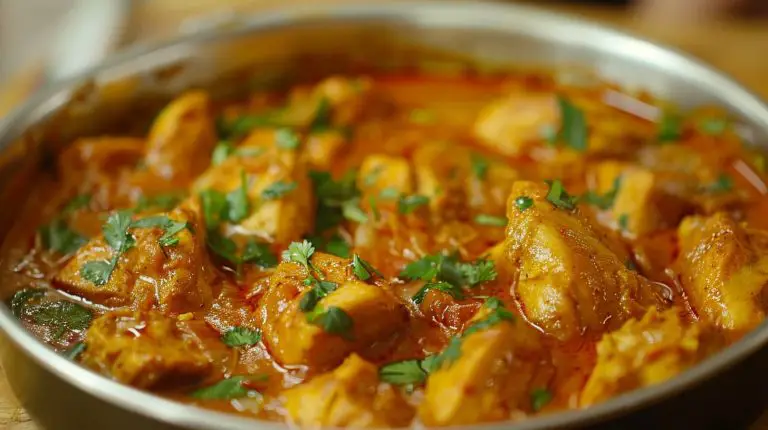Healthy Indian Butter Chicken Recipe for Beginners

Imagine this: After a long day, you’re craving something comforting and delicious, something that warms you from the inside out. That’s when you think of Indian Butter Chicken, the culinary equivalent of a warm hug.
In this guide, I’ll walk you through the art of making the perfect Indian Butter Chicken, sharing tips and tricks I’ve gathered along the way.
You’ll learn how to select the right spices to achieve that authentic flavor, the importance of marination for tender, fall-off-the-bone chicken, and how to get the creamy sauce just right, avoiding common pitfalls. But that’s not all. I’ll also show you how to adapt this recipe to various dietary needs, ensuring that everyone can enjoy this comforting dish.
Whether you’re cooking for a special occasion or just looking to spice up your weeknight dinner routine, mastering Indian Butter Chicken will not only impress your taste buds but also give you a confidence boost in the kitchen.
In this guide, you’ll learn
- The Intriguing History Behind The Indian Butter Chicken Recipe
- How to make mouth-watering Indian Butter Chicken Recipe in your kitchen
- Healthy Vegan Alternatives For The Items Used In the Recipe
- Common Mistakes To Avoid, Pro Tips To Enhance The Taste Of the Dish
- FAQs (Reader Questions Answered) and much more stuff!
So, grab your apron, and let’s dive in!
Quick History Of The Indian Butter Chicken Recipe
- Butter Chicken, also known as Murgh Makhani in Hindi, has its roots in the historical bylanes of Delhi, India.
- The dish was accidentally invented by Kundan Lal Gujral, a chef and the owner of the renowned Moti Mahal restaurant, in the 1950s.
The story goes that Gujral decided to simmer leftover tandoori chicken pieces in a creamy tomato gravy, rich with butter and spices, to avoid wasting them. This inventive dish quickly gained popularity, becoming a staple of Indian cuisine and a symbol of culinary innovation.
Butter Chicken is often served during special occasions, festivals, and gatherings in India.
Regional Variations of Indian Butter Chicken Recipe:
While the basic ingredients of Butter Chicken remain consistent, regional variations exist that reflect local tastes and ingredient availability.
- In some parts of North India, for instance, the gravy might be richer, containing more cream and butter.
- In contrast, other regions might emphasize a tangier taste by adding more tomatoes or a hint of dried fenugreek leaves (Kasuri Methi) to the sauce.
Fun Facts about Butter Chicken:
- Global Love: Butter Chicken has transcended borders, becoming beloved worldwide. It’s often one of the first dishes people try when exploring Indian cuisine, thanks to its mild spice levels and creamy texture.
- Culinary Staple: It inspired the creation of Chicken Tikka Masala, a dish rooted in the same basic cooking principles as Butter Chicken.
- Versatile Ingredient: The Butter Chicken sauce has found its way into pizzas, pasta, and even as a dip, showcasing its versatility and universal appeal
How to make Restuarant Style Indian Butter Chicken Recipe At Home
Ingredients:
For the Chicken Marinade:
-
- 500g chicken breast, cut into bite-sized pieces (For a vegetarian option, use firm tofu cubes)
- 1 cup Butter or Greek yogurt
- 1 tbsp ginger-garlic paste
- 1 tsp turmeric powder
- 1 tsp garam masala
- 1/2 tsp paprika (optional for a mild heat)
- 1 tsp red chili powder
- Salt to taste
For the Sauce:
-
- 2 tbsp olive oil (a healthier fat choice)
- 1 large onion, finely chopped
- 1 tbsp ginger-garlic paste
- 2 bay leaves
- 1 can (400g) crushed tomatoes
- 1 tsp turmeric powder
- 1½ tsp garam masala
- 1 tsp coriander powder
- 1 tsp cumin powder
- 1 tsp paprika or Kashmiri chili powder (for color and a gentle heat)
- 1 cup cream (Can substitute with coconut cream) [for that creamy texture without dairy]
- Salt to taste
- 1 tsp honey (optional, for a touch of sweetness)
- Fresh cilantro (coriander leaves), for garnish
Cooking Instructions:
Starting with the Marinade
- In a large mixing bowl, mix Greek yogurt with ginger-garlic paste, turmeric, garam masala, paprika (optional), red chili powder, and salt.
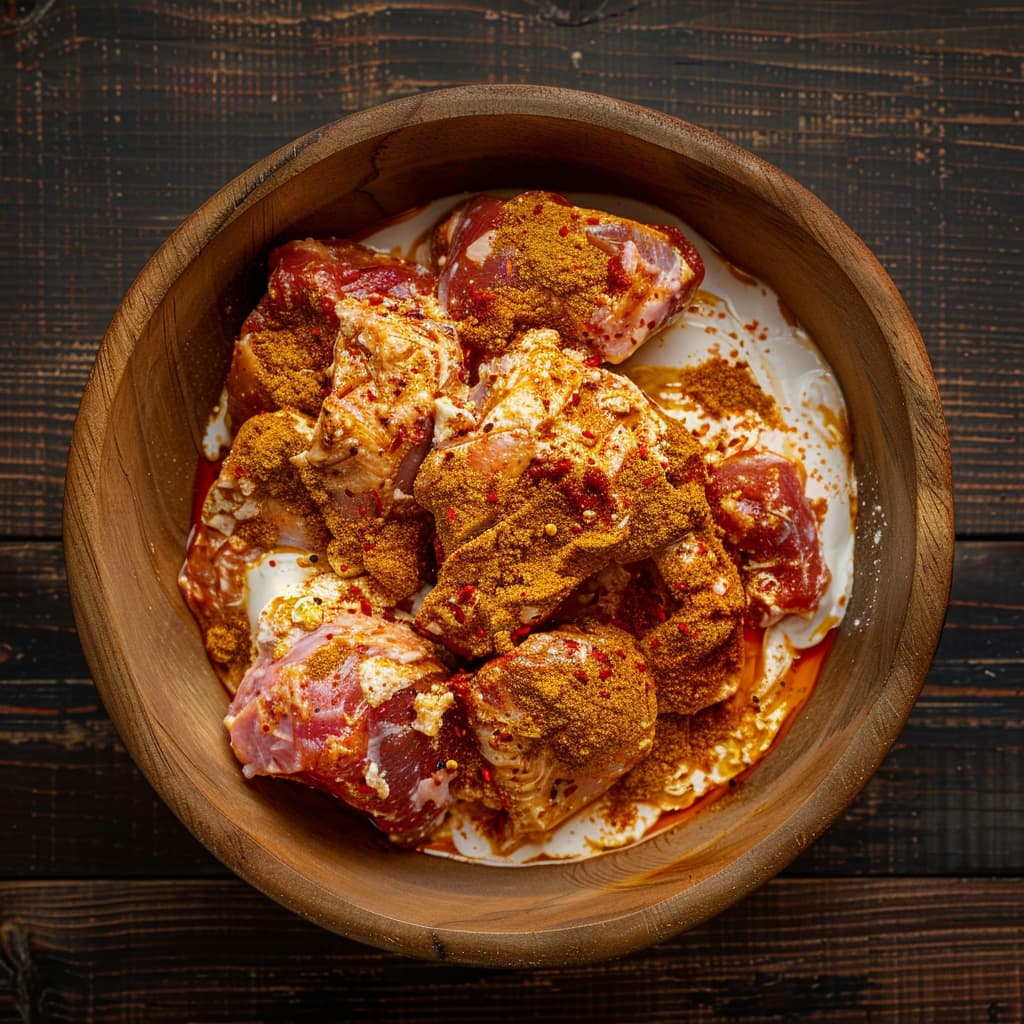
- Thoroughly coat each piece of chicken with the marinade. When I say to ensure each piece is well-coated, I mean to get in there with your hands (clean, of course) and massage the marinade into the chicken.
- It’s a bit messy, but this hands-on approach ensures every nook and cranny is flavored.
- Pop this in the fridge. I usually let it sit overnight, but if you’re pressed for time, even an hour will do wonders.
Crafting the Sauce
- Now, the heart of the dish – the sauce. Heat your pan over a medium flame and sizzle the olive oil.
- Add those finely chopped onions. This part tests your patience; cook them slowly until they’re beautifully golden. It’s tempting to rush, but those caramelized onions lay the foundation for our sauce’s depth of flavor.
- Then, ginger-garlic paste goes in.
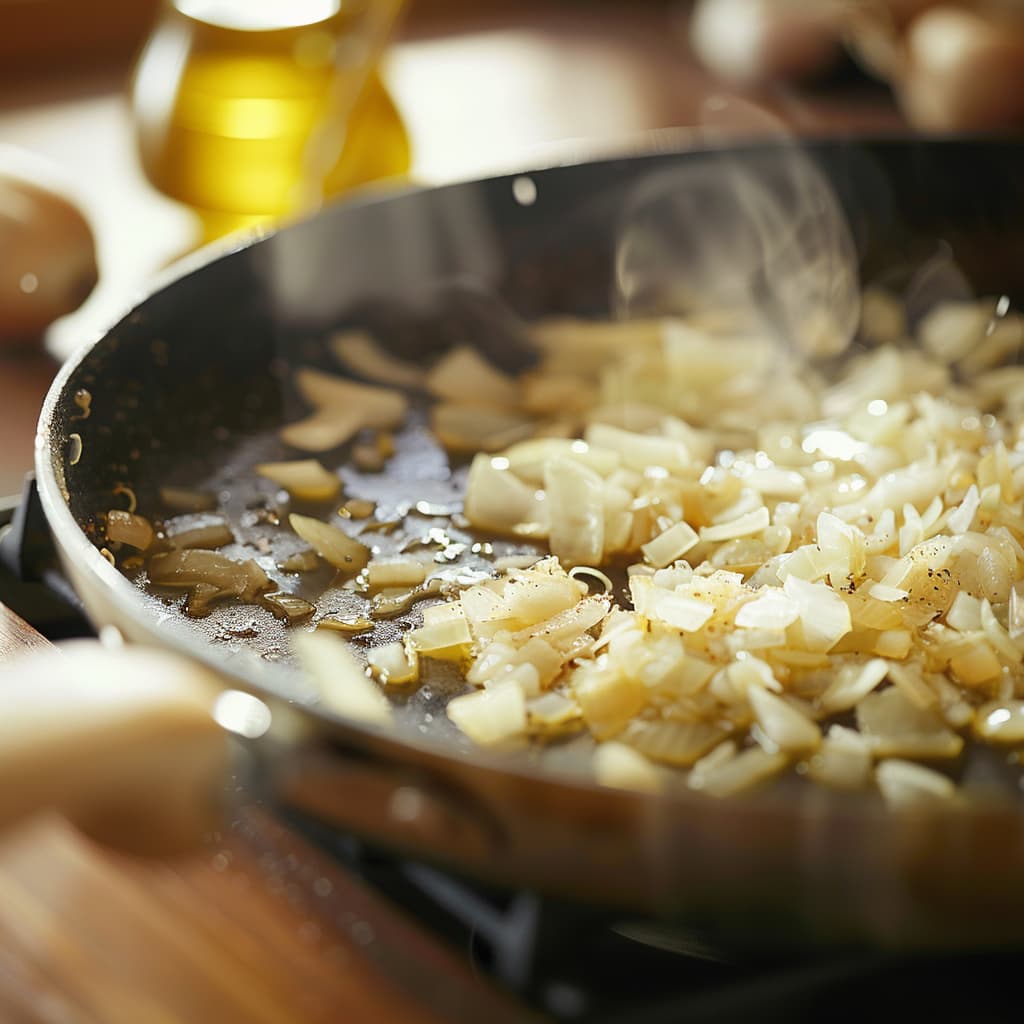
- Once you’ve sautéed it for a minute (yes, you’ll smell its amazing aroma), it’s time for the bay leaves, tomatoes, and spices.
- Add 2 bay leaves, crushed tomatoes, turmeric powder, garam masala, coriander powder, cumin powder, and paprika/Kashmiri chili powder. Mix well.
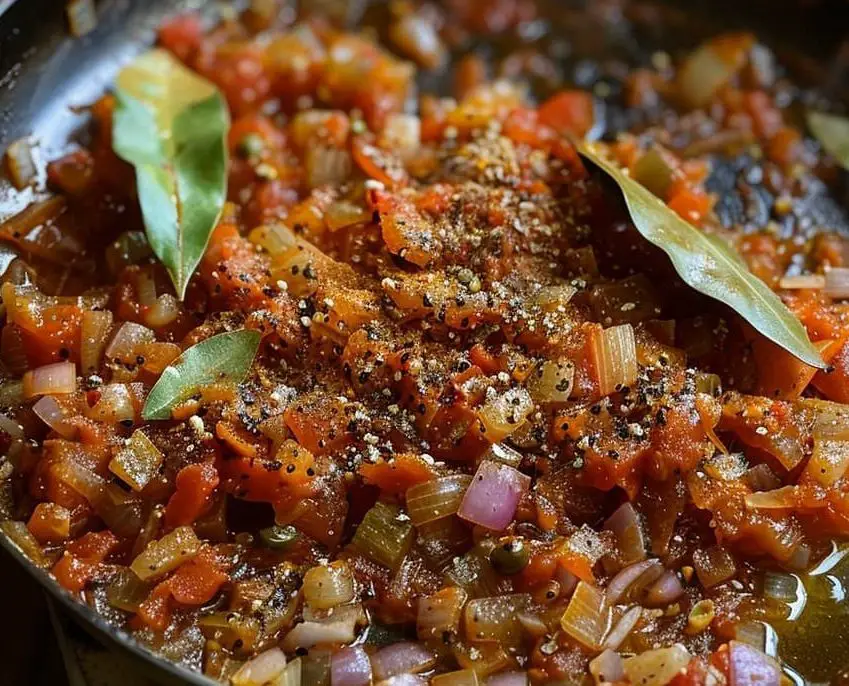
- Allow the mixture to simmer for 10-15 minutes, stirring occasionally, until it thickens slightly.
- After adding the coconut cream, watch as it transforms into a creamy, dreamy sauce.
- Remember, a gentle simmer here is your friend. Season with salt. Add honey if desired for a touch of sweetness. Simmer the sauce on low heat, stirring regularly, until it reaches a rich and creamy consistency.
Cooking the Chicken
- While our sauce gently bubbles, let’s grill the chicken. Achieving that perfect char without overcooking is key.
- If you’re like me and sometimes worry about undercooked poultry, use a meat thermometer to check for doneness; you’re aiming for 165°F (74°C) inside.
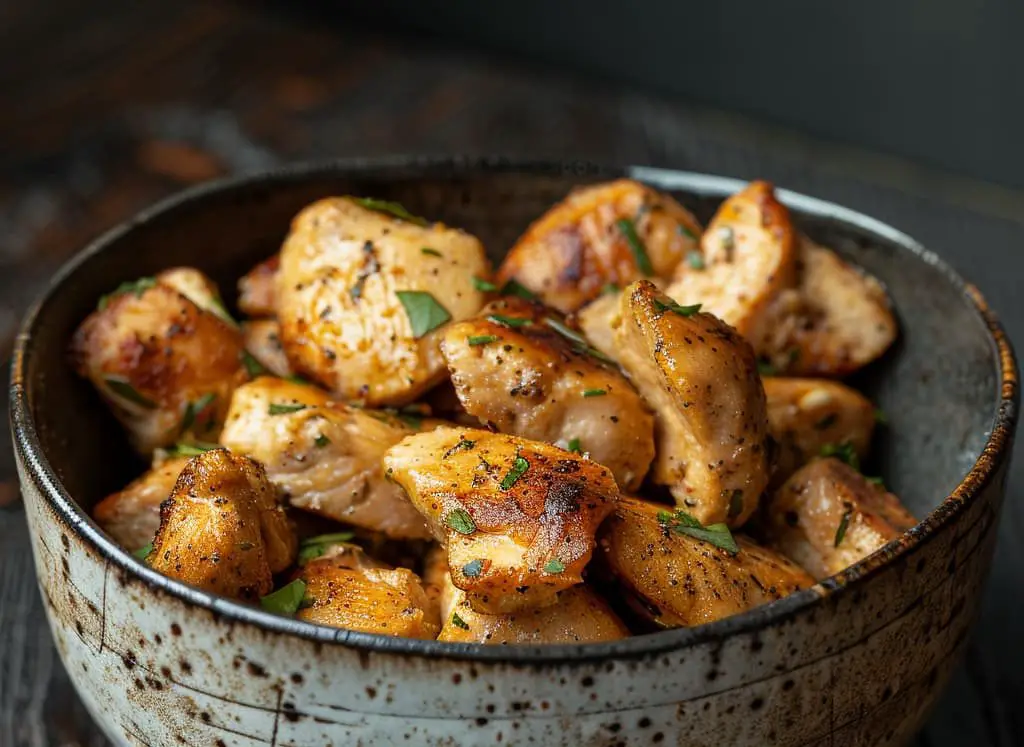
- No grill? No problem. An oven set to 400°F (200°C) will also give you great results. Just flip the pieces halfway through to ensure an even cook.
Alternative Pot Cooking Method:
-
- Heat a tablespoon of olive oil in a large pot over medium heat.
- Add the marinated chicken pieces (or tofu cubes) to the pot. If the marinade is thick, you can add a little water (about 1/4 cup) to ensure it doesn’t burn and stick to the chicken or tofu.
- Cover the pot with a lid and let the chicken cook for about 20-25 minutes, stirring occasionally to prevent sticking and ensure even cooking. For tofu, reduce the cooking time to 10-15 minutes since you’re looking to warm it through and achieve a slight browning.
- Halfway through cooking, you can check and stir the chicken to ensure it’s cooking evenly. If the mixture seems too dry, add a splash of more water.
- Once the chicken is fully cooked (reaching an internal temperature of 165°F or 74°C) or the tofu is heated through and lightly browned, remove from heat.
Bringing It All Together
- Once your chicken is perfectly cooked and your sauce has thickened to just the right consistency, combine them.
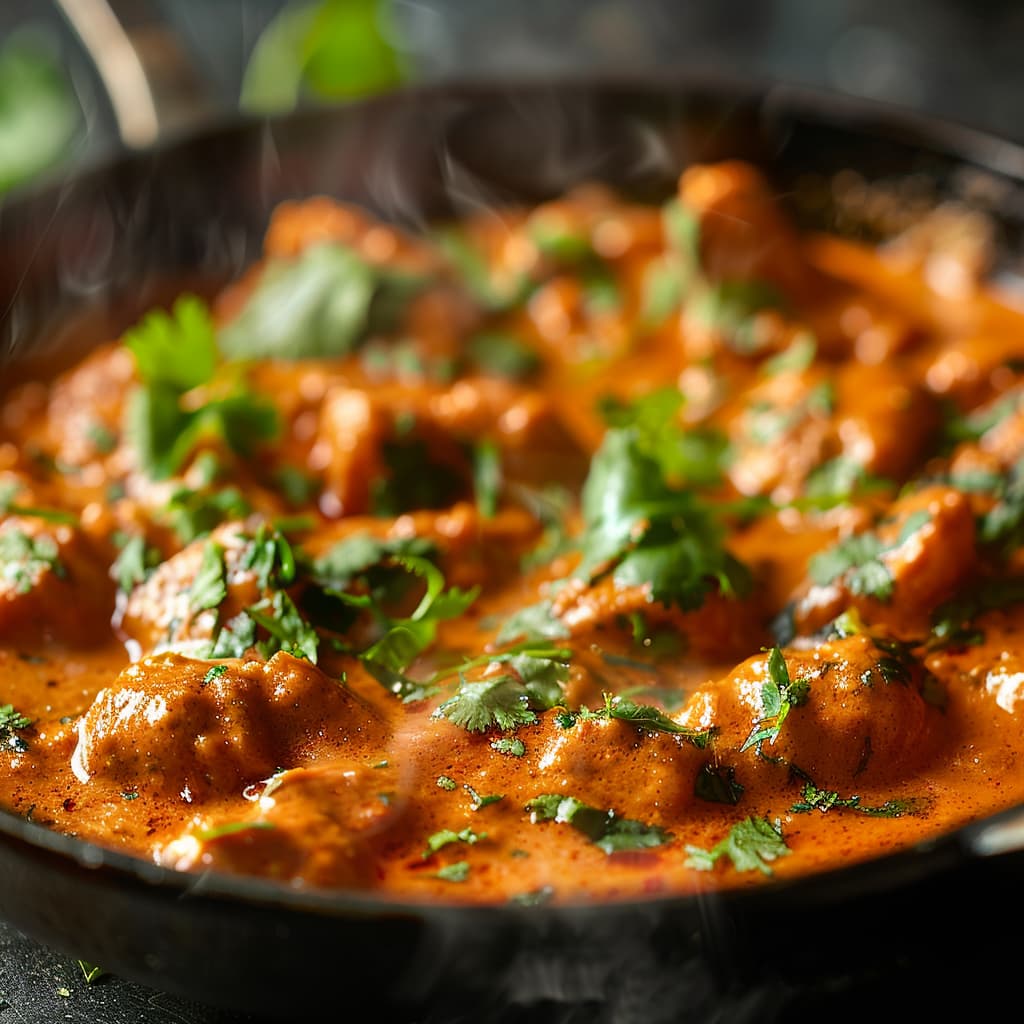
- Stir gently to coat every piece of chicken with the sauce. Letting it simmer for a few more minutes means our chicken will not just be flavored on the outside, but soaked with deliciousness through and through.
Serving It Up
- Spoon this creamy, spiced delight onto a bed of fluffy rice or quinoa, and sprinkle it with fresh cilantro.
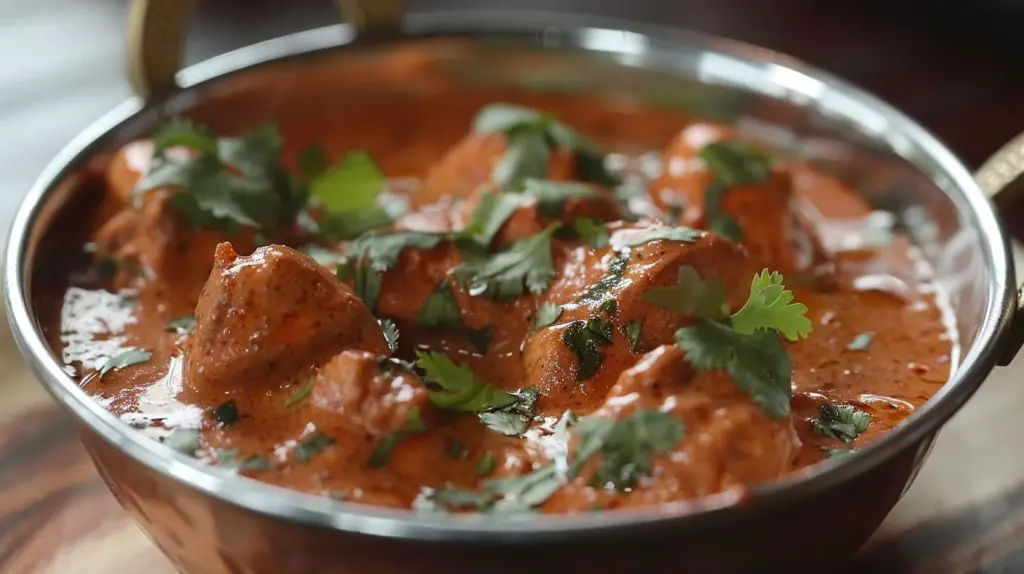
- The vibrant greens not only add a pop of color but a fresh flavor contrast that elevates the whole dish.
Healthy Vegan Alternatives For The Ingredients Used In the Indian Butter Chicken Recipe
For the “Chicken”:
- Jackfruit: Young green jackfruit in brine or water has a texture similar to chicken when cooked and can absorb flavors well, making it an excellent substitute.
- Tofu: Extra-firm tofu, pressed to remove excess moisture, can be cubed and used as a hearty protein source. Marinate and bake or pan-fry for added texture.
- Tempeh: Tempeh, made from fermented soybeans, offers a nutty flavor and firm texture. Slice or cube, then marinate and cook as you would chicken.
For Greek Yogurt in Marinade:
- Vegan Yogurt: Many plant-based yogurts are made from coconut, almond, soy, or oat milk. Choose an unsweetened, plain variety to replicate the tanginess of Greek yogurt.
- Cashew Cream: Blend soaked cashews with water, lemon juice, and a pinch of salt until smooth for a homemade alternative that adds creaminess to the marinade.
For the Cream in the Sauce:
- Coconut Cream: Offers richness and creaminess without dairy. It also complements the spices used in butter chicken.
- Cashew Cream: Made by blending soaked cashews with water until smooth. It provides a neutral flavor and creamy texture.
- Almond Cream: Similar to cashew cream but made with almonds, it’s another great alternative for adding creaminess to the sauce.
For Honey:
- Maple Syrup: A natural sweetener that can replace honey. It adds a mild sweetness without affecting the overall flavor profile too much.
- Agave Syrup: Another vegan-friendly sweetener, agave syrup is closer to honey in consistency and sweetness level.
For Butter:
- Vegan Butter: Many brands offer plant-based butter that can be used for frying spices and onions to achieve that rich buttery flavor in the sauce.
Mistakes To Avoid While Making Indian Butter Chicken
1. Ingredient Selection:
- Common Errors: Choosing lean cuts of chicken over more flavorful, juicy parts; using artificial ginger-garlic paste instead of fresh; opting for low-fat cream or milk.
Solutions: Select thigh pieces for their juiciness and flavor. Always use fresh ginger and garlic for the marinade and sauce.
Full-fat cream is essential for that rich, creamy texture Butter Chicken is known for. If you must substitute, use coconut cream for a dairy-free alternative that doesn’t compromise on richness.
2. Preparation Pitfalls:
- Marinating Time: Rushing the marination process. The depth of flavor in Butter Chicken comes from letting the chicken marinate, absorbing all the spices.
- Cutting Techniques: Inconsistently sized chicken pieces can lead to uneven cooking.
Solutions: Marinate the chicken for at least 4-6 hours, though overnight is ideal. Cut chicken into uniform pieces to ensure they cook evenly.
3. Cooking Techniques:
- Inconsistent Heat: A common mistake is cooking the sauce on too high heat, causing the dairy to curdle, or too low, not allowing the flavors to meld properly.
- Overcrowding the Pan: Adding all the chicken at once can lower the temperature of your pan, resulting in boiled rather than seared chicken.
Solutions: Cook the sauce on medium heat to prevent separation and achieve a smooth consistency. Sear the chicken in batches if necessary to maintain a high enough temperature for that perfect golden exterior.
4. Seasoning and Flavoring:
- Over/Under-seasoning: One of the trickiest parts is getting the seasoning right. Butter Chicken should have a perfect balance of tangy, sweet, and savory.
- Too Much Heat: While some like it hot, traditional Butter Chicken is mild and creamy.
Solutions: Start with less salt and spices, gradually adding more to taste. Use Kashmiri red chili for color without overwhelming heat. Balance the tang from tomatoes with a hint of sugar or honey if needed.
5. Presentation Tips:
- Cluttered Presentation: Overdoing it with garnishes can take away from the dish’s natural appeal.
Solutions: Serve Butter Chicken in a simple, elegant bowl or dish. A light sprinkle of mint leaves and a drizzle of cream can enhance its appearance without overcomplication. Offer basmati rice and naan bread on the side to complete the meal.
Pairing Suggestions for Indian Butter Chicken
- Beverages: A light, crisp lager or a Riesling wine complements the dish’s richness without overpowering its flavors. For a non-alcoholic option, a mango lassi or a spiced chai tea can balance the creaminess and spices wonderfully.
- Side Dishes: Fluffy basmati rice or garlic naan bread are classic pairings, perfect for soaking up the sauce. A cooling cucumber raita or a tangy kachumber salad (diced cucumber, tomato, and onion salad with lemon juice) provides a refreshing contrast to the dish’s warmth.
- Other Main Courses: If serving as part of a larger meal, consider pairing with saag paneer (spinach and cottage cheese) for a vegetative note, daal tadka (lentil soup) for added protein, or aloo gobi (potato and cauliflower) for a comforting vegetable side.
Seasonal Variation options for this Recipe
- Spring: Lighten the dish by incorporating fresh peas or asparagus into the sauce, adding a touch of spring’s sweetness and crunch. Serve with a side of lemony herbed rice to embrace the season’s fresh flavors.
- Summer: Offer a summery twist by adding grilled, diced mango or peach to the sauce for a hint of fruity sweetness that complements the spices. Accompany with a chilled cucumber mint salad to cool the palate.
- Fall: Embrace the warmth of fall by adding roasted pumpkin or sweet potato to the dish, bringing in a comforting, earthy element. Serve with warm, spiced flatbread to enhance the cozy factor.
- Winter: Increase the heat with additional garam masala or introduce winter greens like kale or Swiss chard into the sauce for a hearty, nutritious boost. Pair with pilau rice featuring nuts and dried fruits to add texture and a wintry feel.
Always Keep In Mind, that the inclusion of newer veggies or spices can end up impacting the overall taste of the dish, so you may need to adjust your other spices or salt portions to counter that.
Common Problems You May Face While Cooking Indian Butter Chicken
Problem 1: Chicken Isn’t Tender
- Solution: The key to tender chicken is in the marination. Make sure to marinate your chicken for at least 4 hours, or ideally overnight.
- This not only infuses it with flavor but also tenderizes it. Using yogurt in your marinade will help break down the proteins, making the chicken soft and succulent.
Problem 2: Sauce Isn’t Creamy Enough
- Solution: Achieving that velvety sauce texture is crucial. If your sauce feels too thin, simmer it longer to reduce and thicken. Adding a bit more cream can also help.
- Remember, the sauce will continue to thicken upon cooling, so give it a little time to set before deciding it’s too runny.
Problem 3: Sauce Curdling
- Solution: Curdling can happen if the cream is added to the sauce when it’s too hot. To prevent this, reduce the heat to low before incorporating the cream. Also, stirring continuously as you add the cream can help maintain a smooth consistency.
Problem 4: The Dish Is Too Spicy or Too Bland
- Solution: Spice levels can be tricky, especially in dishes like Butter Chicken. If it’s too spicy, add a bit more cream or a spoonful of honey to balance the heat.
- If it’s too bland, a pinch more of garam masala, chili powder, or salt can elevate the flavors. Remember, it’s easier to add than to subtract, so start with less and build up according to your taste.
Problem 5: Unsure of When the Chicken Is Cooked
- Solution: It’s important not to overcook the chicken, as it can become dry.
- Cut into the thickest part of a piece to check; the juices should run clear, and there should be no pink meat. Using a meat thermometer can also take the guesswork out—chicken is safe to eat at 165°F (74°C).
Problem 6: Butter Chicken Tastes Different from Restaurants
- Solution: Restaurant-style Butter Chicken often has a depth of flavor developed through slow cooking and specific spice blends. To mimic this, ensure you’re using fresh, high-quality spices.
Adding a smoky flavor can also bring your dish closer to what you might find in a restaurant.
You can achieve this by using a small piece of charcoal: heat it until red, place it in a small metal bowl, add a teaspoon of oil, and then place the bowl in your sauce pot. Cover the pot for a minute or two to infuse the sauce with a smoky flavor.
Problem 7: Rice Is Either Too Sticky or Undercooked
- Solution: Cooking perfect basmati rice can be as much of an art as the Butter Chicken itself.
- Rinse your rice in cold water until the water runs clear to remove excess starch. Then, use a 1:2 ratio of rice to water. Bring to a boil, then simmer with the lid on until the water is absorbed and the rice is fluffy.
Tips for Perfecting Indian Butter Chicken Recipe
- Marination Magic: Use Greek yogurt for marinating the chicken. Its thickness adheres better to the chicken, ensuring each piece is thoroughly coated and tenderized, resulting in deeper flavor penetration.
- Low and Slow Tomato Reduction: Cook your tomato base on a low flame for an extended period. This concentrates the flavors and naturally sweetens the sauce, reducing the need for added sugars.
- Spice Layering: Toast and grind your spices for the marinade and sauce. Layering freshly ground spices at different cooking stages builds a more complex flavor profile, far superior to pre-ground versions.
- Cream Versus Cashew Paste: For a richer, nuttier sauce, consider blending soaked cashews into a paste and using it in addition to or in place of cream. This not only thickens the sauce but also adds a velvety texture and a subtle sweetness.
- Charred Chicken: For an authentic touch, char the marinated chicken pieces under a broiler or on a grill before adding them to the sauce. This adds a smoky flavor reminiscent of traditional tandoori cooking.
- Finishing Touches: A final sprinkle of dried fenugreek leaves (Kasuri Methi), crushed between your palms, and a dollop of butter stirred in off the heat can dramatically enhance the dish’s aroma and flavor.
FAQs about Indian Butter Chicken Recipe (Reader Questions Answered)
Q1: Can I use chicken breast instead of thigh pieces?
- Absolutely, you can use chicken breast if you prefer. Just keep in mind that breast meat can dry out more easily, so be careful not to overcook it. Marinating it for a longer period can help keep it tender.
Q2: What if I don’t have fresh fenugreek leaves?
- Fresh fenugreek leaves (Kasuri Methi) add a unique flavor, but if you can’t find them, a good substitute is a pinch of dried fenugreek leaves. They’re stronger in flavor, so use them sparingly. If you don’t have either, you can skip it, though the dish will miss that distinctive taste.
Q3: How can I make this dish dairy-free?
- For a dairy-free version, substitute the cream with coconut cream and use oil instead of butter. These substitutes will slightly change the flavor profile but still result in a delicious dish.
Q4: My sauce is too thin. How can I thicken it?
- If your sauce is too thin, let it simmer uncovered on low heat to reduce and thicken. Stir occasionally to prevent sticking. If you’re in a hurry, a small slurry of cornstarch and water can also do the trick—just add it slowly and stir until you reach the desired consistency.
Q5: Can I make Butter Chicken in advance?
- Yes, Butter Chicken tastes better the next day as the flavors have more time to meld. Just refrigerate it after cooling and reheat gently before serving. It can also be frozen for up to a month.
Q6: The dish is too spicy for my taste. How can I adjust it?
- If the dish turns out too spicy, you can add more cream to help neutralize the heat. Another option is to add a bit of sugar or honey to balance the flavors.
Q7: Can I use canned tomatoes instead of fresh ones?
- Yes, canned tomatoes are a perfectly fine substitute for fresh ones in Butter Chicken. They might even save you some cooking time. Just be mindful of their added salt or seasoning.
Q8: How do I achieve the smoky flavor found in restaurant versions?
- To add a smoky flavor to your Butter Chicken, you can use the charcoal method mentioned earlier or add a drop of liquid smoke. Be cautious with liquid smoke, as a little goes a long way.
Q9: Can I make Indian Butter Chicken without a grill?
- Yes, you can broil the marinated chicken in the oven until it has a slight char on the edges, or pan-fry it over high heat to achieve a similar effect.
Q10: How can I substitute cream to make the dish healthier?
- You can use coconut milk for a lighter version, which adds creaminess without the dairy. Greek yogurt is another alternative but add it slowly and on low heat to avoid curdling.
Q11: What if I don’t have all the traditional spices?
- While certain spices are key to the dish’s authenticity, you can use garam masala as a substitute for a combination of missing spices. It won’t be identical, but it will still be delicious.
Q12: Can Indian Butter Chicken be made in advance?
- Absolutely, and it tastes even better the next day as the flavors have more time to meld. Just reheat gently, adding a little water if the sauce has thickened too much in the fridge.
So that was it…Let me know in the comments about what you feel about this recipe.
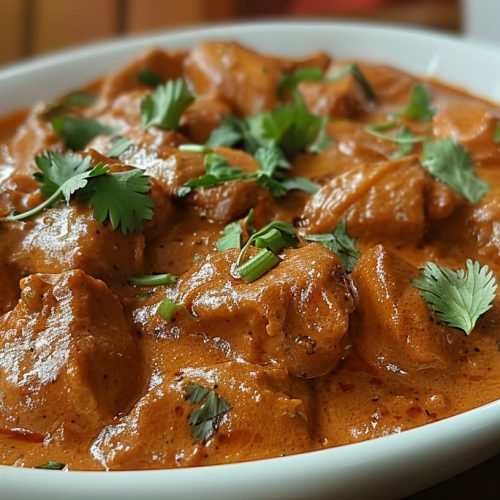
Healthy Indian Butter Chicken Recipe
Ingredients
For the Chicken Marinade:
- 500 g chicken breast cut into bite-sized pieces (For a vegetarian option, use firm tofu cubes)
- 1 cup Butter or Greek yogurt
- 1 tbsp ginger-garlic paste
- 1 tsp turmeric powder
- 1 tsp garam masala
- 1/2 tsp paprika optional for a mild heat
- 1 tsp red chili powder
- Salt to taste
For the Sauce:
- 2 tbsp olive oil a healthier fat choice
- 1 large onion finely chopped
- 1 tbsp ginger-garlic paste
- 2 bay leaves
- 1 can 400g crushed tomatoes
- 1 tsp turmeric powder
- 1½ tsp garam masala
- 1 tsp coriander powder
- 1 tsp cumin powder
- 1 tsp paprika or Kashmiri chili powder for color and a gentle heat
- 1 cup cream Can substitute with coconut cream [for that creamy texture without dairy]
- Salt to taste
- 1 tsp honey optional, for a touch of sweetness
- Fresh cilantro coriander leaves, for garnish
Instructions
Starting with the Marinade:
- In a large mixing bowl, mix 1/3rd cup of butter or Greek yogurt with ginger-garlic paste, turmeric, garam masala, paprika (optional), red chili powder, and salt.
- Thoroughly coat each piece of chicken with the marinade. When I say to ensure each piece is well-coated, I mean to get in there with your hands (clean, of course) and massage the marinade into the chicken.
- It's a bit messy, but this hands-on approach ensures every nook and cranny is flavored.
- Pop this in the fridge. I usually let it sit overnight, but if you're pressed for time, even an hour will do wonders.
Crafting the Sauce:
- Now, the heart of the dish – the sauce. Heat your pan over a medium flame and add the rest of the butter.
- Add those finely chopped onions. This part tests your patience; cook them slowly until they're beautifully golden. It’s tempting to rush, but those caramelized onions lay the foundation for our sauce's depth of flavor.
- Then, ginger-garlic paste goes in.
- Once you’ve sautéed it for a minute (yes, you’ll smell its amazing aroma), it’s time for the bay leaves, tomatoes, and spices. Add 2 bay leaves, crushed tomatoes, turmeric powder, garam masala, coriander powder, cumin powder, and paprika/Kashmiri chili powder. Mix well.
- Allow the mixture to simmer for 10-15 minutes, stirring occasionally, until it thickens slightly.
- After adding the coconut cream, watch as it transforms into a creamy, dreamy sauce. Remember, a gentle simmer here is your friend. Season with salt. Add honey if desired for a touch of sweetness. Simmer the sauce on low heat, stirring regularly, until it reaches a rich and creamy consistency.
Cooking the Chicken:
- While our sauce gently bubbles, let's grill the chicken. Achieving that perfect char without overcooking is key.
- If you’re like me and sometimes worry about undercooked poultry, use a meat thermometer to check for doneness; you’re aiming for 165°F (74°C) inside.
- No grill? No problem. An oven set to 400°F (200°C) will also give you great results. Just flip the pieces halfway through to ensure an even cook.
Alternative Pot Cooking Method:
- Heat a tablespoon of olive oil in a large pot over medium heat.
- Add the marinated chicken pieces (or tofu cubes) to the pot. If the marinade is thick, you can add a little water (about 1/4 cup) to ensure it doesn't burn and stick to the chicken or tofu.
- Cover the pot with a lid and let the chicken cook for about 20-25 minutes, stirring occasionally to prevent sticking and ensure even cooking. For tofu, reduce the cooking time to 10-15 minutes since you're looking to warm it through and achieve a slight browning.
- Halfway through cooking, you can check and stir the chicken to ensure it's cooking evenly. If the mixture seems too dry, add a splash of more water.
- Once the chicken is fully cooked (reaching an internal temperature of 165°F or 74°C) or the tofu is heated through and lightly browned, remove from heat.
Bringing It All Together:
- Once your chicken is perfectly cooked and your sauce has thickened to just the right consistency, combine them.
- Stir gently to coat every piece of chicken with the sauce. Letting it simmer for a few more minutes means our chicken will not just be flavored on the outside, but soaked with deliciousness through and through.
Serving It Up:
- Spoon this creamy, spiced delight onto a bed of fluffy rice or quinoa, and sprinkle it with fresh cilantro.
- The vibrant greens not only add a pop of color but a fresh flavor contrast that elevates the whole dish.

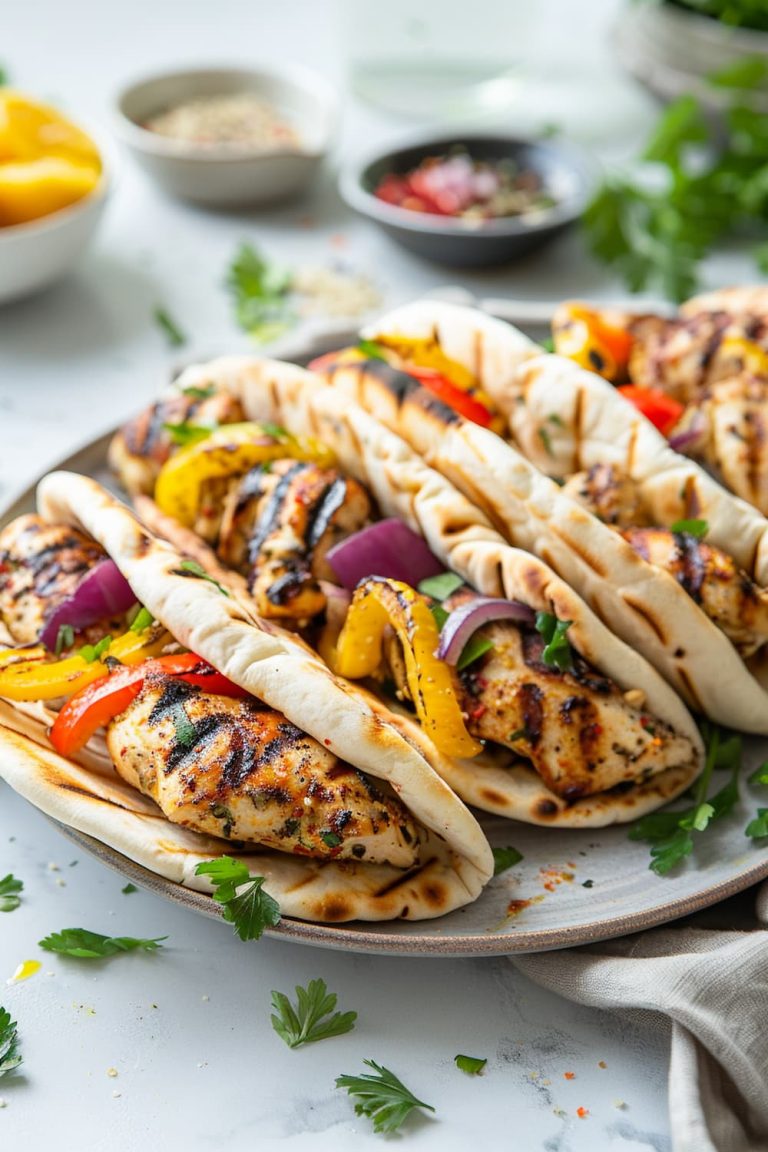
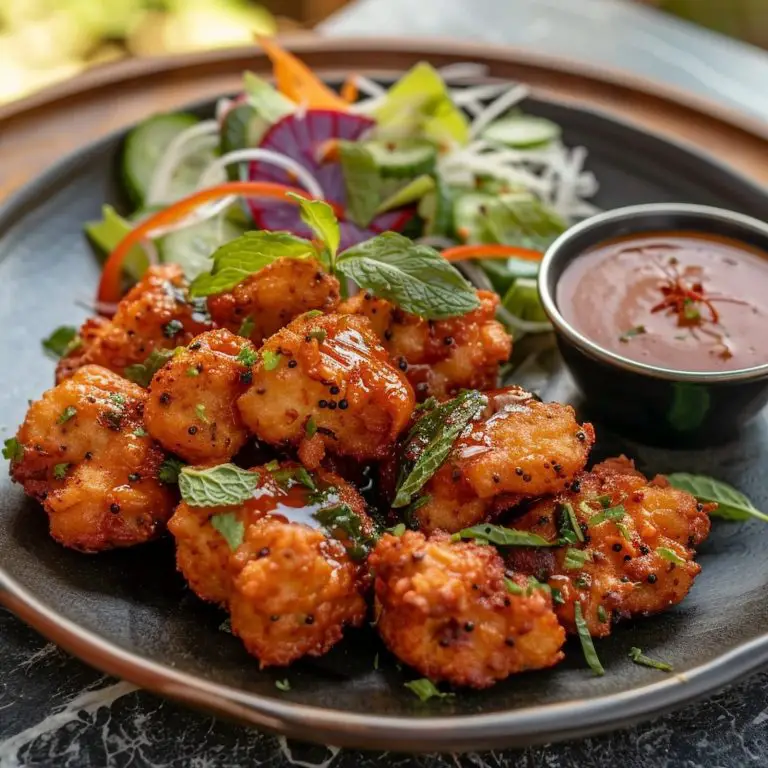
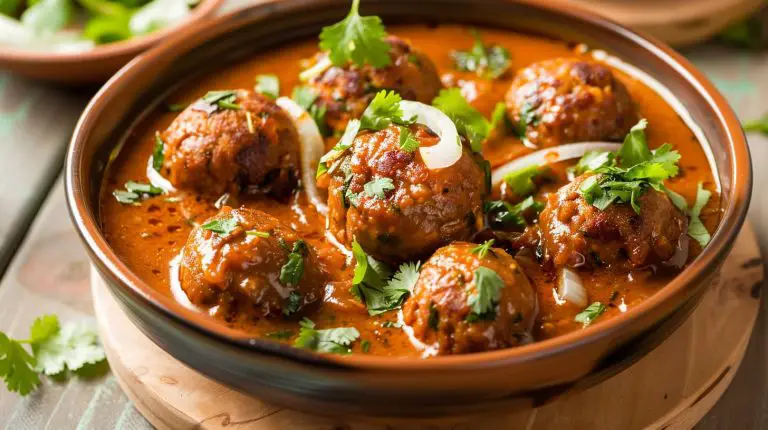
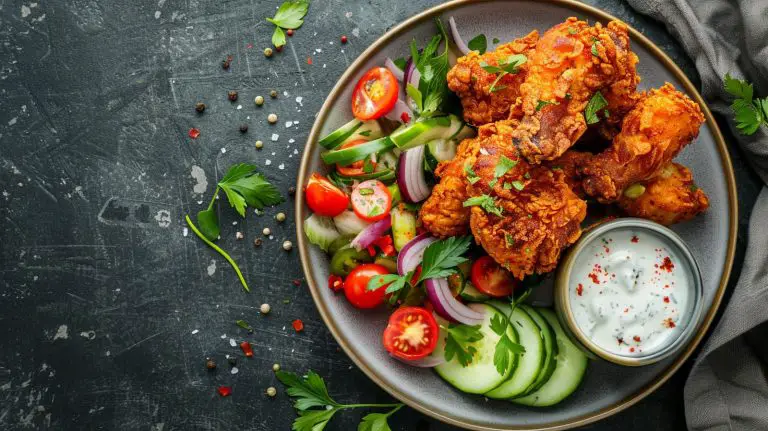
![glossy saucy consistency curry, [chili soy chicken]](https://tastycookingaroma.com/wp-content/uploads/2024/04/almostawake21_glossy_saucy_consistency_curry_chili_soy_chicke_f005f0d9-98f1-4956-8251-e7b98f5e61fc_2-768x430.jpg)
